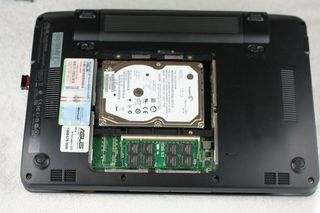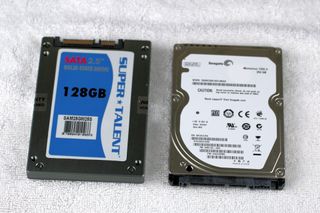How-To: Upgrade Your Netbook, Easily
Pep up your dumbed-down netbook with these easy projects: upgrade RAM, get a bigger hard disk, and add SD flash memory. Trust us, this is easy.
Swapping Out the Asus Eee PC 1000HE Hard Drive
As with the Dell Mini 9 maneuver, this is a very easy mechanical task. The 1000HE supports SATA II drives, so you need only remove a single anchor screw for the drive caddy from the case, then pop out the old drive, replace the old drive in the caddy with a new one (up to four more screws), insert the drive caddy back into its receptacle, and replace the anchor screw, and you’re done.
But first, of course, that drive must be imaged just like the Mini 9’s SSD. In this case, however, you can use an external drive caddy like the ThermalTake BlackX to make this job very easy. We just popped out the original 160 GB hard disk from the 1000HE case, dropped it into the caddy, plugged it into another PC, and then used Acronis TrueImage to write an image of that drive onto another drive. Next, we popped the old drive out of the BlackX, popped in the new one, used TrueImage to restore the drive, and were back up and running in less than half an hour from our start time. No need to burn a boot disk or build a bootable UFD, and no need to restore using the target machine itself. SATA drive tools make this task much easier for the Asus Eee PC 1000HE than it was for the Mini 9.
Here are some snapshots of the drive swap, with step-by-step instructions:
- Look for the screws that hold the drive cage in place around the drive bay, then remove that screw. The photo shows the drive in the bay with the cage removed so you can see the screw aperture clearly at the lower right beneath the stock Seagate 160 GB drive.


- Unscrew the old drive from the drive cage, then insert the new drive and replace all four screws.
- Lower the drive cage into the drive bay so that the internal SATA connector mates up to the SATA connector on the drive. Gently push the drive to the left until it’s firmly seated on the SATA connector. Replace the anchor screw for the drive cage at the lower right, tighten until snug.
And again: you’re done. Whereas we saw read speeds ranging from 68 to 40 MB/s with the original 160 GB drive, we saw 100 to 60 GB/s with the 250 GB drive (thanks in part to its faster rotation, but also thanks to its larger 16 MB drive cache), and a straight 110 MB/s across the board for the 128 GB SSD. Given that the SSD costs more than five times as much as the 250 GB HD, we think it’s only workable for those with big budgets, which defeats the purpose of having a netbook in the first place. We’re using the 250 GB drive in our unit ourselves.
Sign up to get the BEST of Tom's Guide direct to your inbox.
Get instant access to breaking news, the hottest reviews, great deals and helpful tips.
Current page: Swapping Out the Asus Eee PC 1000HE Hard Drive
Prev Page Upgrading the Dell Mini 9 SSD Next Page Making the Upgrade Call-
jlee0585 ActiveMP made a similar set of tutorials as videos for the EeePC and the Mini 9. You might want to check it out.Reply
Here are the links:
http://www.youtube.com/watch?v=0TciyrKjLfU (EeePC)
http://www.youtube.com/watch?v=ARz6GbQnCwg (Mini 9)
Btw, you might want to remove the batteries before you remove and replace any internal parts. Just to be safe. ActiveMP also sells SSD replacements so you might want to check them out. -
mikestech I upgraded my Dell Mini 9 from the stock 8GB SSD to the 64GB Runcore SSD. I noticed a significant performance improvement. It's amazing what this little machine can do with a fast SSD and 2GB of RAM. I even occassionaly use it for video editing in Sony Vegas 9.Reply
Mike
http://solidstatedrivehome.com
-
I recently upgraded the hard disk in my Toshiba Satellite pro that had a 60 GB hard drive, with a Seagate 320GB 7200.3 drive. The disk cloning process I did using the DOS version of Seagates Seatools. In all I managed to complete the cloning and disk changeover in 40 minutes. It runs like a dream and is detectably faster in operation.Reply
Seatools is free, fast, small and relatively simple to use with a nice GUI in DOS. I have to admit I have tweaked the basic DOS configuration to recognise USB drives. -
mr_tuel Total cost of a netbook plus upgrades is > buying a full size laptop that is more powerful to begin with.Reply -
Well, mr_tuel, if you want to lug around 5 or 6 lbs with an optical drive you rarely use, feel free to carry your large, awkward full-size laptop. Size, portability and low weight are why these little beauties are such hot sellers. I just bought a 1000HE and love it.Reply
-
Luscious 2GB ram upgrades are a no-brainer at $25. I'm anticipating Win7 will replace XP as the de-facto Windows OS for netbooks.Reply
Not all netbooks come with 2.5" drives, and finding replacements for 1.8" models or units that use proprietary connectors/cradles will create trouble. Not all netbook hard drives are as easy to get to either.
Bumping up storage and ram won't do much though if you need more performance or a higher-res display. I was lucky to grab a HP 2133 last year that's still working well for me, but I'm eager to trade up to a Pinetrail unit as soon as Intel gets its act together. -
jn77 Ok, so I have had a Toshiba NB-205 for about 4 weeks now and I have upgraded it to 2gb, a 500gb 7200rpm drive, and Windows 7 RC. ( I understand that these are not suppose to be "Notebooks") but I want to know if there is any way to get around the 2gb ram limit.Reply
Is it a bios update, is it tied to the hardware, what will happen if I get a 4gb module to put in the netbook? -
michaelahess I've got a Mini 9 with the same 32GB SDD you guys used. Also have a touchscreen, gps, 8GB SD card, and an internal 4GB microSD card/reader. I use OS X almost exclusively for it and it works wonderfully. The stock 4GB SSD sucked and would pause at random. i've had no issues with speed on this guy. Best most usable laptop I've ever had. I always bring my normal laptop with but hardly ever use it except for work.Reply -
etittel Thanks for all the great comments and pointers. As for 4 GB in the netbooks, everything I've researched seems to indicate that Intel limits RAM to 2 GB as part of the Atom chipset/motherboard design specs. That said, I'm buying a couple of 4 GB SO-DIMMs for another machine of mine and will definitely pop one into either or both of these netbooks to see what happens. If they work or not, either way I'll report back here.Reply
As for the Aspire omission: I purchased both of these netbooks with my own hard-earned cash. The chancellor of the exchequer--my wife, that is--forbade me to purchase a 3rd netbook for cost reasons. If you want to loan me your Aspire, I'll gladly make the upgrades and photograph them, then return it to you exactly as it was sent to me (and cover shipping both ways). I wanted to get one of those, and a Samsung, and a ..., but "you can't always get what you want."
Thanks again to one and all,
--Ed--
